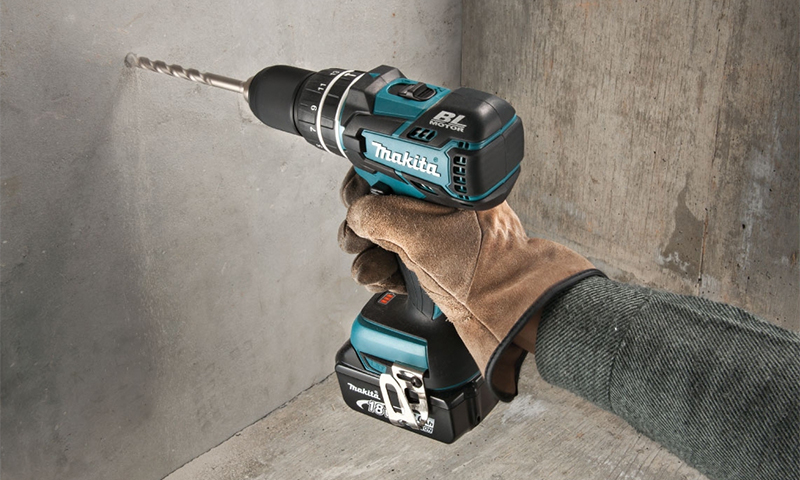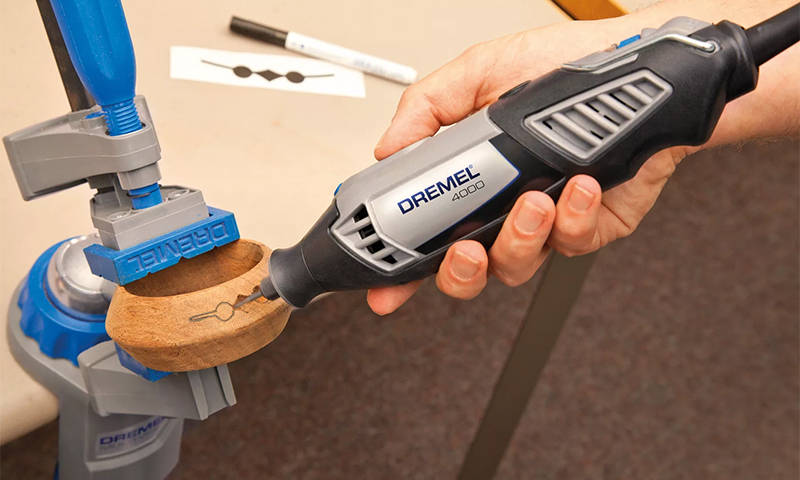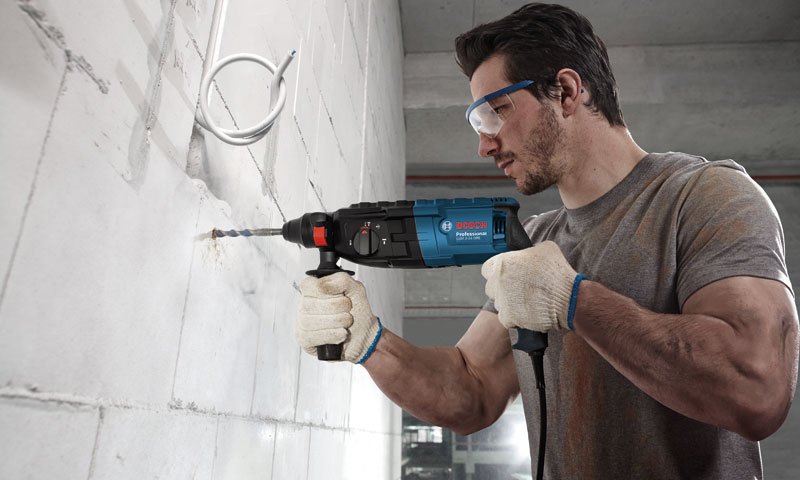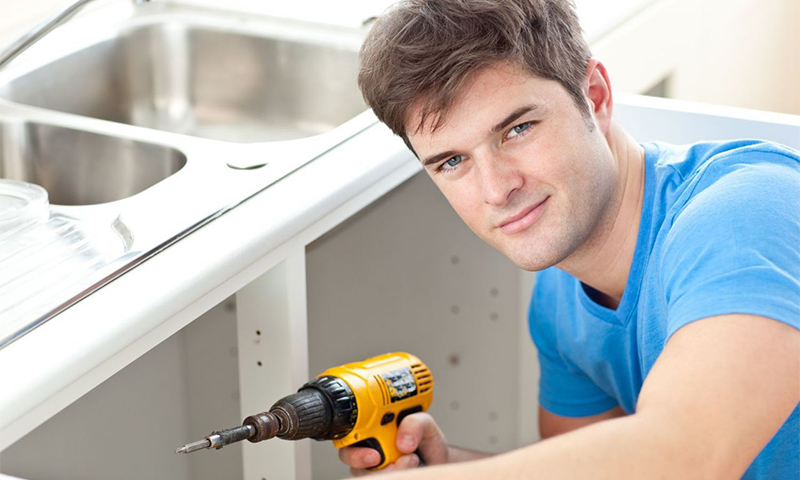Drill greatly facilitates the execution of holes in brick, tile, metal or wood. It is used from garage workshops to large enterprises. It is useful to have such a tool in the country or in the apartment. Some devices can make small holes and work several hours a day, while others are capable of interacting with crowns and full-time. To find the best tool for your business, it is important to understand the key parameters and their impact on the process, which will be discussed in this article.

Content:
The best manufacturers of drills - which company to choose
If you need to quickly drill a couple of holes and have this tool for periodic needs at hand, then the following companies produce good models:
- Bosch;
- Dewalt;
- Hitachi;
- Metabo;
- Elitech.
But the capabilities of some models are very different from others, so it is reasonable to read an article about top drills. For self-determination of the key characteristics of the tool and the choice for a specific activity, the material below is prepared
The principle of operation and the device drill
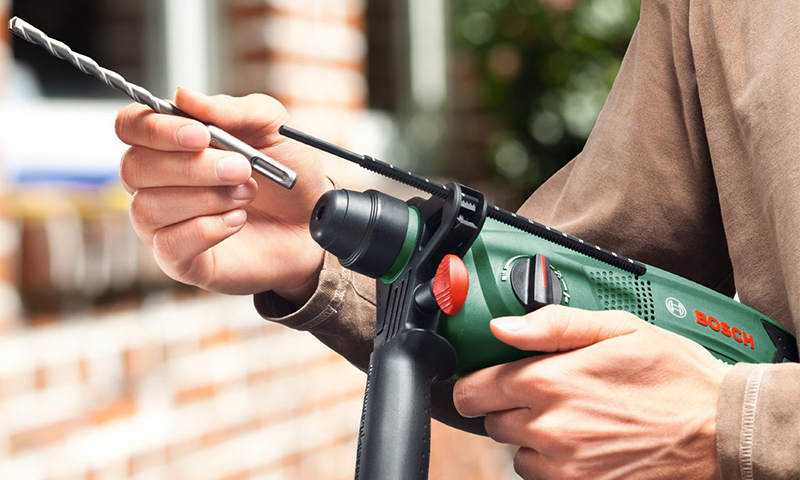
The drill is applied in many production and construction processes. With its help they perform drilling in brick, metal, wood, tile and even natural stone.
This tool is convenient:
1. Prepare holes for the sidebar lock;
2. Attach a metal shell;
3. Make holes for the ventilation grille in the wall;
4. Run the cable through the ceiling and roofing materials;
5. Unscrew the screws from wood or drywall;
6. Knead the solution for putty;
7. Create attachment points on the metal structure;
8. Run decorative elements on the stone;
9. Prepare holes in the ceramic tile for electrics or plumbing.
The principle of operation of the apparatus is to rotate the armature of the electric motor, to which voltage is transmitted from the brushes. The armature shaft is connected to the chuck with a clamped drill. Circular movements at high speeds contribute to the rapid cutting of the upper layer of material and the depth of the drill. The chips come out through special channels in the form of a drilling element.
The key unit of the drill is the chuck, which is able to push its clamping jaws or bring them very close, which determines the maximum and minimum diameter of the working drill and the ability to perform holes of a certain size.
For control on the case there is a trigger that starts the rotation and a latch button to facilitate long drilling. Some models are equipped with a reverse for turning the torque in the opposite direction. It is used to unscrew self-tapping screws or more easily remove the drill bit from hard materials.
To determine the depth of approach, a limiter is provided, which is fixed on the side and does not allow the tool to go further when it reaches a certain point. This is convenient in the case of thin partitions and precise drilling.
Some models are equipped with a percussion mechanism, which makes not only rotational movements, but also tapping, which accelerates the drilling of hard materials. The principle of operation of such a device is to use a "drunk" bearing, in which the walking trajectory of rotation, at high speeds, produces blows.
The drill device includes:
1. Electric motor;
2. Brushes;
3. Safety clutch;
4. Gears for torque transmission;
5. Bearings;
6. Cartridge;
7. Start and shift button.
Types of drills
Network
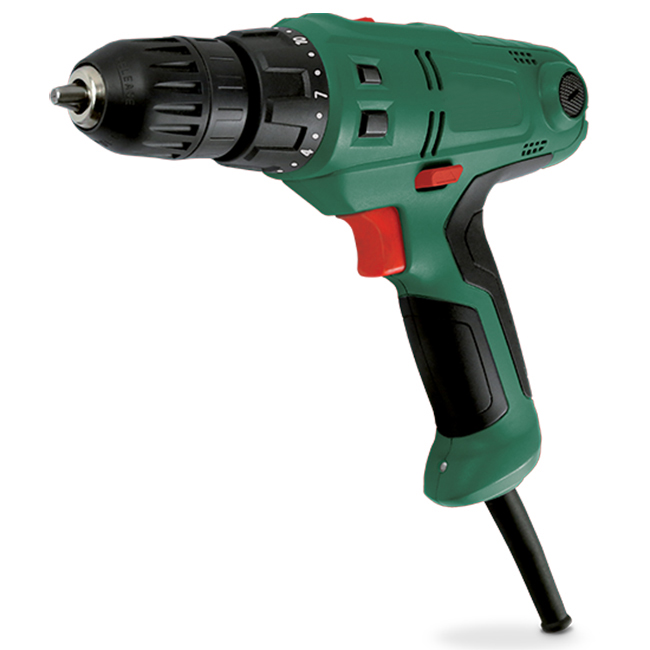
The most common tool with an electric motor operating from a household network of 220 V.Models have a large range of power and maximum drilling diameter in various materials. They are applied at the dacha, small workshops and large productions.
Advantages:
- power variety;
- there is a shock function;
- widespread use on materials;
- metal cartridges;
- ergonomic design;
- low cost;
- comfortable grip;
- emphasis on the handles.
Disadvantages:
- work is limited by the length of the cord;
- the weight of some models is inconvenient for ceiling work;
- speed switches can be located in an awkward place;
- plastic case cracks when dropped.
Rechargeable
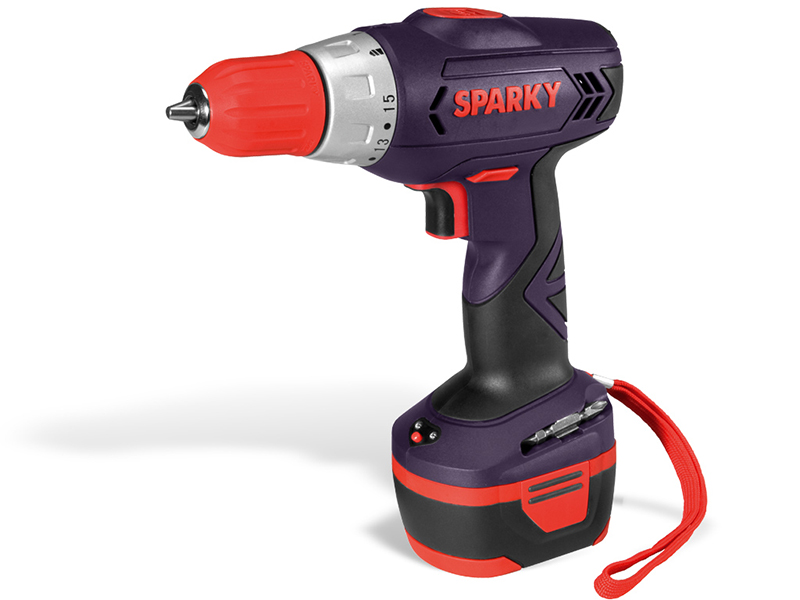
The tool is characterized by autonomy due to a small battery built into the lower part of the handle.
This makes the drill much heavier, but it allows you to drill holes in objects where there is no electricity or not to waste time unwinding the carrying and quickly move from one workplace to another.
Such models are used for assembling and installing furniture or when repairing by visiting craftsmen (emergency opening of doors, installation of hanging furniture and equipment).
Advantages:
- do not depend on the outlet and the length of the cord;
- maintain a drilling diameter of up to 20 mm in wood and 10 mm in metal;
- the kit often comes with two batteries for changing and continuous activity;
- overload protection;
- versatility.
Disadvantages:
- running time is limited by battery capacity;
- heavy;
- the battery on the handle interferes in a confined space;
- may not have enough power for solid materials.
Pneumatic
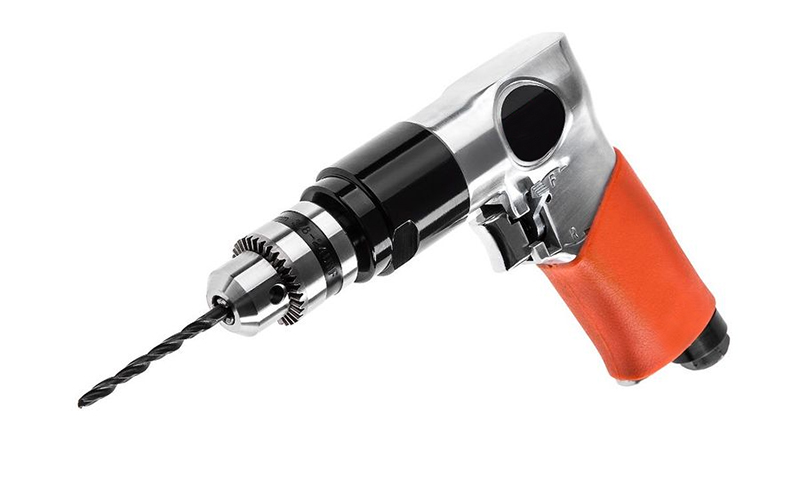
The device operates from compressed air supplied from the compressor. Consumption is 115-140 liters per hour. For communication using a flexible hose and fitting. The models differ in different spindle speeds and, due to the absence of an electric motor, do not heat up.
Due to the simple design, they have a light weight. They are used for full-time employment, where there is an appropriate air supply system or compressor. These are plants and production shops, or volume constructions.
Advantages:
- lungs;
- use for 8-10 hours every day;
- do not heat up;
- compact body;
- metal durable handle;
- different spindle rotation range.
Disadvantages:
- an air supply system or portable compressor is required;
- radius of the working area is limited by the length of the hose.
Diamond drilling
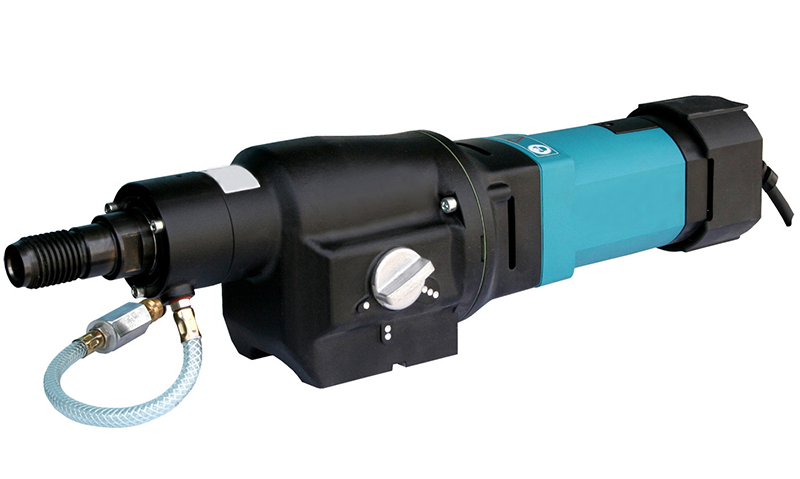
These are powerful 2000 W drills that are used with drills or bits and diamond tips to make holes in reinforced concrete, ceramics, marble tiles.
The device weighs 4-7 kg and can work in a dry mode, where dust is blown away, or in a wet one, with a directed stream.
Thanks to such equipment it is possible to drill with a diameter of up to 130 mm. They are used in construction when making holes in solid natural and artificial materials, as well as a stone master.
Advantages:
- high power;
- two modes of operation;
- several speeds at the gearbox;
- the ability to make holes in very hard materials;
- wide scope.
Disadvantages:
- increased dimensions;
- large mass;
- high price;
- expensive components.
Drill selection options
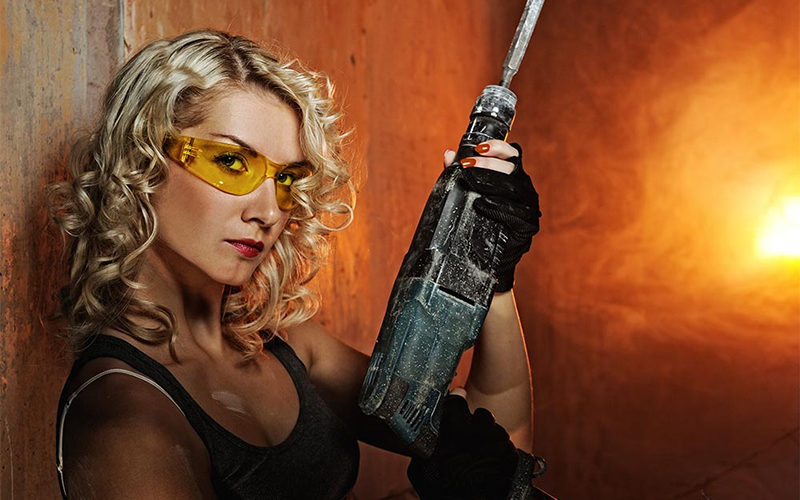
Power
The ability of a tool to drill hard materials or the speed of work depends on the power rating. It is from 230 to 2000 watts. The higher the value, the faster the device will cope with the thickness or the stronger you can press on the handle and the equipment will not jam, but continue drilling.
1. For small work in the country enough drill 400 watts.
2. Exit emergency crews or repair specialists will need a model of 600-700 watts.
3. Professional builders use at work drills from 1000 watts.
4. Factories or plants for processing metal or stone used equipment from 1500 to 2000 watts.
Number of speeds
Some materials, if drilled at low speeds, will remain intact. Others from such a rotation will heat up and deform.The third types will drill through very quickly and, possibly, the holes will turn out to be with an extra depth. Good for frequent types of work of the same type to have a certain set speed.
Some drills work at the same speed, which is regulated by the number of revolutions. But constant adjustment takes time when changing materials (after wood it is required to work with metal or brick), and the accuracy of forced reduction or increase in speed leaves much to be desired.
Therefore, drills with 2-4 speeds have been developed, where the user can pre-set acceptable revolutions for each position and change them by simply switching during operation.
1. The tool at 2 speeds is useful to those who work constantly with two materials differing in density (steel and wood).
2. The 4-speed model is useful for craftsmen who have to drill concrete, metal, wood and plastic. To switch to a new material, it suffices to replace only the drill.
Type of cartridge
One of the main elements of the drill is the chuck, which holds the drill and does not allow it to turn idly or sink into the retainer. There are several types of cartridges that differ in the clamping mechanism.
They keep the drilling element equally well, but differ in the principle of operation and convenience:
1. Key - has clamping cams, shifting in three points due to the rotation of the key along the teeth on the chuck. Effectively fixes the drill, but to change the element requires a key. In order not to lose and have it at hand, it is attached to the wire of the instrument. This type of cartridge is suitable for gardening or in activities where frequent change of drills is not required.
2. Fast-tightening - works like a button, by moving the top part off, the drill seat is captured. Releasing fixes it and you can immediately begin to work. The use of a key is not required and it can be replaced with one hand. This is the best option for builders who often have to change the diameter of the holes to be made or switch to drilling other materials.
3. Collet - performs clamping by tightening the nut. This is done without a key, but it takes two hands on the cartridge, or a grip with the hand and a slow rotation of the motor for the draw. The type of cartridge is suitable for repairmen, in car-care centers and other activities where it is necessary to periodically install a different drill diameter.
Reverse
Above the trigger, some models have a reverse lever, which starts the rotation in the opposite direction. This makes it easier for the drill to protrude out of the hole, which will help those who work with hard materials and large thickness (500 mm wall, 20-30 mm metal plate).
The second possibility of reversing is unscrewing screws at lower revs. So, you can quickly disassemble the cabinet, remove the dead lock or dismantle the fastening of the plasterboard partition. This feature will be useful to workers of furniture products and builders.
Backlight
The accuracy of the drill setting at the start affects the performance of the holes in the right place. To do this, on the body of the drill may be a diode that illuminates the working area of the device. This is useful for those who have a poorly lit workplace or constantly have to change it.
Illumination is needed especially for plumbers, because under the bathroom, sink or in the basement may not be enough lighting.
Maximum drilling diameter
All cartridges are capable of clamping small drills of 2-3 mm, but the maximum value of each model is different. This figure differs from the type of material, so before buying it is important to make sure that the tool can perform the desired hole size despite the specific hardness of the object.
1. For drilling bricks, the maximum can be from 10 to 82 mm.
2. Models with indicators of 10-30 mm will be useful in the country, for the installation of plumbing.
3. Indicators of 40-80 mm are necessary for builders to create air vents, laying heating pipes and other works.
4. When working with metal, the hole diameter from some drills is limited to 6 mm, while others are capable of breaking up to 32 mm in width.
5. When drilling wood drills can make holes from 9 to 70 mm. Installing locks requires the ability to work with crowns of 30-40 mm. Large figures are used only in decorative works.
Stepless adjustment
On the drill trigger can be wheel, the rotation of which sets the depth of the button and the speed of drilling.
This adjustment allows you to change the speed not in steps, but smoothly. This is useful to those who work with materials of similar hardness, where it is necessary to accelerate the rotation only slightly when switching from one type to another (from copper to aluminum, from foam concrete to concrete).
This function is also useful when drilling plastic and similar substances, where high speed leads to heating and melting of the hole.
Length of cable
Network models depend on electricity, and the radius of the working area is limited by the length of the cable from the outlet. The length of the wire can be 1.5-4 meters.
1. If the work is carried out constantly on a workbench or table, then the minimum size will suffice.
2. At the service station you can buy a drill with a wire of 2-2.5 m.
3. In construction, it is better to use a cable of 3-4 meters, since the use of carrying makes it difficult to lift a tool with a wire and work at height.
Shock function
Rotation from the motor to the cartridge is transmitted through a gear inside the device. But at this stage of the chain there may be another element - the “drunk” bearing.
It has a curved shape and, when working, its faces also perform longitudinal movements, which is felt as a quick tapping on the drill.
Such a shock function increases the pressure on the working element and accelerates the passage of the thickness of the material. This is used when drilling bricks, foam blocks, aerated concrete and stone. Such a function is necessary for all builders and apartment renovation masters.
Fixing the "Start" button
Work with a drill begins by placing the drill in the right place and pressing the “Start” button. For the passage of a small thickness of the material (for example, 5 mm of iron, or 20 mm of wood) it will take several minutes. After that, the finger releases the button and the drill is moved to a new location.
But if you have to drill holes to a greater depth in solid material (metal 20-30 mm, brick wall 100-200 mm), then it will take about 10 minutes, and in the case of a large number of such places where similar drilling is required, at the end of the day , pressing on the trigger, very tired.
Therefore, the developers began to provide individual models with the function of locking the “Start” button, where the side key from the natural grip of the hand blocks the release of the trigger and allows, without a load on the finger, to work with materials of greater thickness. Builders and metalworkers will appreciate this.
Tool weight
The weight of the drill can be from 1 to 7 kg. This affects the usability and load on the hands. The heavier the product, the easier it will be to drill in the lower position.
1. For mounting racks under partitions, holes in the floor under the plumbing is better to use a model weighing 5-6 kg.
2. Diamond drills are also distinguished by their great weight, so working with ceramics and natural stone will need to get used to the load on your hands.
3. To perform work at height it is better to buy a lightweight model for 1.5-2 kg.
4. For use in the country or in the garage and vertical holes fit drill 2.5-3 kg.
Suitcase
Some models are sold in a paper box, while others have a plastic case with handles. Their device differs in thoughtful compartments for the tool itself, its cable and place for fixing and storing a set of drills.
This will be very useful for emergency door wizards, plumbers and other professionals who often have to change their jobs. For use at the cottage or garage use, all this can be stored on the shelf and in the case is not necessary.
Body material
Drills can be plastic or metal. This affects their weight.The latter have a body made of aluminum, which significantly increases their strength and resistance to scratches and cracks. Such an instrument survives falls better and serves much longer.
1. To periodically drill at the cottage enough plastic housing.
2. Metal models will be useful for those who often have to lay tools on hard surfaces or work in narrow spatial conditions (builders, plumbing fixtures).
3. When working at height, there are controversial opinions: the tool will be better protected when it falls, but with a lot of weight to lift with your hands above your head. Plastic housing is much easier, but if you drop from a great height, you may have to buy a new drill.
Spindle speed
Pneumatic models operate without an electric motor, and rotation provides compressed air from the compressor. Here the power of the instrument is determined not in watts, but by the number of revolutions per minute. The higher this number is, the more loads the device can carry.
1. The average for working 3-5 hours per day is 1,800 rpm. This is enough for most drilling tasks in the enterprise.
2. If you have to constantly perform holes in solid walls (concrete, red brick, metal), then choose models at 2600 rpm, which is important for builders.
In electric drills, the spindle speed indicates the speed of the work.
1. For giving and infrequent needs, an indicator of 800 rev / min is enough.
2. To use the tool every day in the auto repair shop choose models for 1500 r / min.
3. Drills for 2000-3000 rpm are suitable for professional builders.
What kind of drill to choose
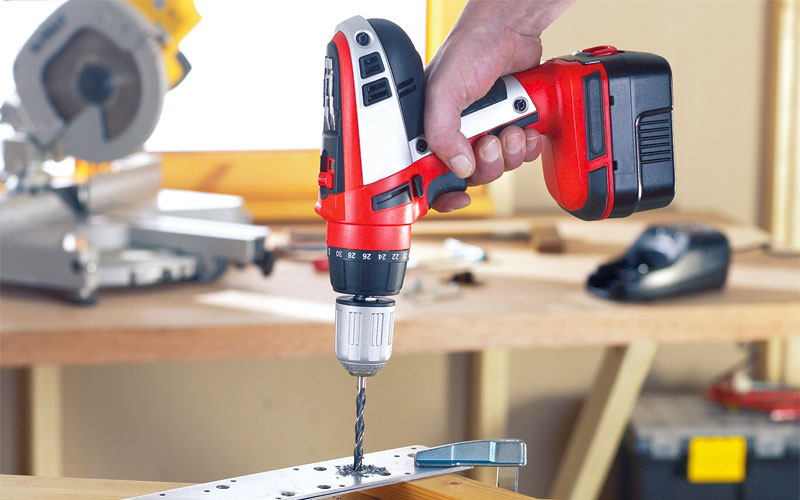
1. The door repair technician or their installers will need a rechargeable model with a maximum drilling for metal of 13 mm and 25 mm for wood, with two replaceable batteries with a capacity of 1.5 A / h, with a reverse, quick-release chuck, in order to easily change drills in operation, weighing 1,4 kg, two speeds for easy transition from a tree to metal. Backlight and case will be very helpful.
2. A simple network model to the country house should have a power of 450 W, a key cartridge, a reverse for easy exit from the hole or use as a screwdriver, the maximum diameter of the holes in the metal is 10 mm and wood 20 mm, weight 1.3 kg, cable length 2 m and one speed.
3. Professional builders need a network tool with a power of 800-1000 W, a keyless chuck, two speeds, lighting, a maximum diameter of 13 mm for metal, a tree of 30 mm and a brick of 16 mm, a shock function, a mass of 1.9 kg, a 4 m wire and a case for transfer. If the case is metal, the equipment will last longer. Spindle speed 2000-3000 rpm
4. For full employment in an enterprise with an air system, an apparatus designed for a pressure of 6 atm is required, with an air flow rate of 110-140 l / min, a spindle speed of 1800-2600 rpm and a collet chuck type.
5. To drill ceramics and natural stone, choose a diamond drill with a capacity of 1700 W, with two speeds, a maximum bore diameter of 132 mm, a weight of 6 kg and adjustment of turns.
How much is a drill
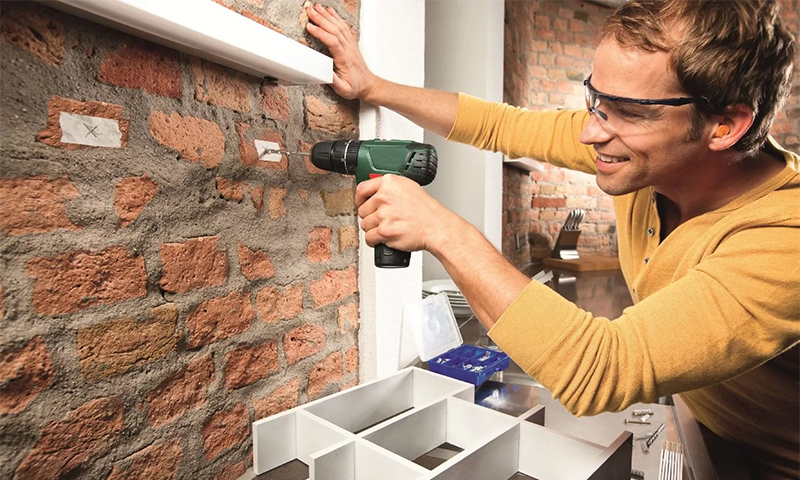
1. For the door master, the device will cost 4000-11000 rubles.
2. To buy a drill to the country you need to spend 1200-2000 rubles.
3. Builders for their tool give 2500-5000 rubles.
4. Pneumatic model for an enterprise costs 2000-12000 rubles.
5. Equipment for working with ceramics and stone costs about 23000-90000 rubles.
It will be interesting to friends too


